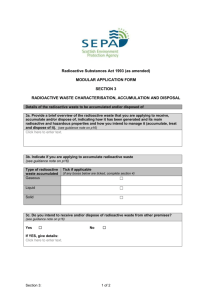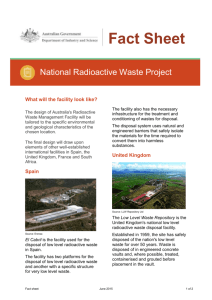Segregation of Radioactive Waste
advertisement
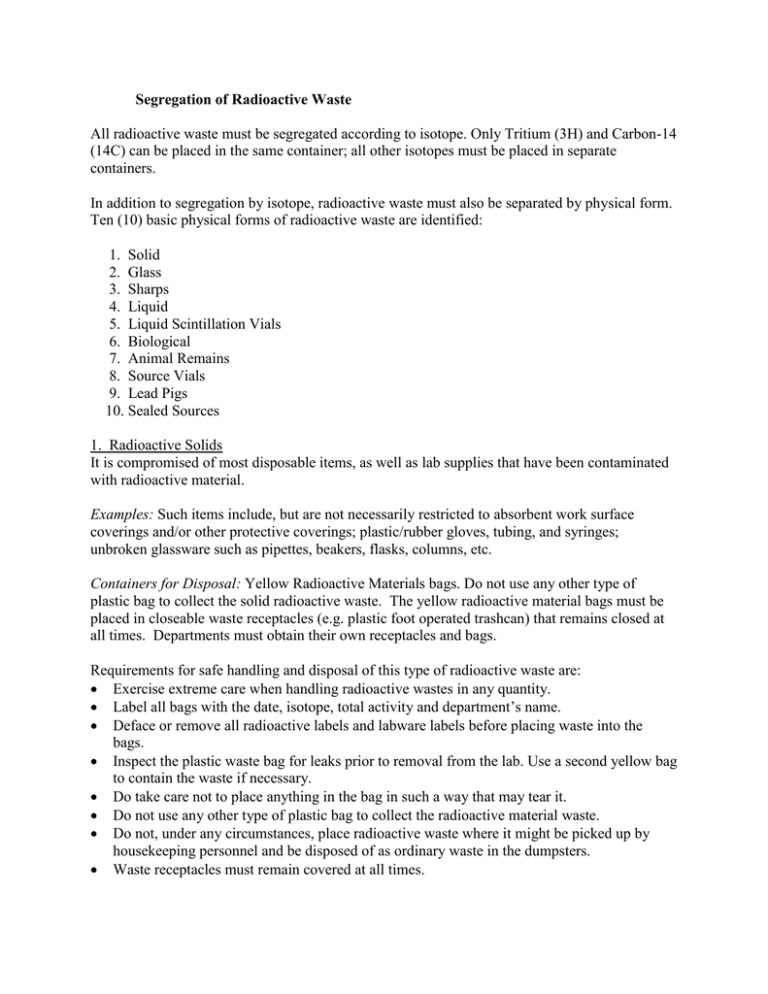
Segregation of Radioactive Waste All radioactive waste must be segregated according to isotope. Only Tritium (3H) and Carbon-14 (14C) can be placed in the same container; all other isotopes must be placed in separate containers. In addition to segregation by isotope, radioactive waste must also be separated by physical form. Ten (10) basic physical forms of radioactive waste are identified: 1. Solid 2. Glass 3. Sharps 4. Liquid 5. Liquid Scintillation Vials 6. Biological 7. Animal Remains 8. Source Vials 9. Lead Pigs 10. Sealed Sources 1. Radioactive Solids It is compromised of most disposable items, as well as lab supplies that have been contaminated with radioactive material. Examples: Such items include, but are not necessarily restricted to absorbent work surface coverings and/or other protective coverings; plastic/rubber gloves, tubing, and syringes; unbroken glassware such as pipettes, beakers, flasks, columns, etc. Containers for Disposal: Yellow Radioactive Materials bags. Do not use any other type of plastic bag to collect the solid radioactive waste. The yellow radioactive material bags must be placed in closeable waste receptacles (e.g. plastic foot operated trashcan) that remains closed at all times. Departments must obtain their own receptacles and bags. Requirements for safe handling and disposal of this type of radioactive waste are: Exercise extreme care when handling radioactive wastes in any quantity. Label all bags with the date, isotope, total activity and department’s name. Deface or remove all radioactive labels and labware labels before placing waste into the bags. Inspect the plastic waste bag for leaks prior to removal from the lab. Use a second yellow bag to contain the waste if necessary. Do take care not to place anything in the bag in such a way that may tear it. Do not use any other type of plastic bag to collect the radioactive material waste. Do not, under any circumstances, place radioactive waste where it might be picked up by housekeeping personnel and be disposed of as ordinary waste in the dumpsters. Waste receptacles must remain covered at all times. 2. Radioactive Glass Contaminated glassware and other unbroken glass should be packaged separately from other solid radioactive waste. Containers for Disposal: A strong cardboard box properly labeled and sealed is adequate for disposal use. 3. Radioactive Sharps Sharps are defined as anything that could tear the yellow radioactive materials bag. Examples: Needles, broken glass, glass pipettes, razor blades, capillary tubes, etc. Containers for Disposal: Puncture resistant plastic tubes. When full, securely recap with orange/red top and properly label tube. Requirements for safe handling and disposal of this type of radioactive waste are: Care must be taken to not injure oneself during placement of sharps into container. Do not attempt to overfill container. Do make sure that all sharps are dry before placing into container. When full, securely cap tube with orange/red top. 4. Radioactive Liquid The category of radioactive liquid waste can be further divided into: (a) Aqueous, (b) Organic, and (c) Other liquids. Examples: (a) Aqueous Liquids - Water-based liquids with a pH between 5.0-9.0, such as saline and buffer solutions or washings from contaminated laboratory glassware, weak acids or bases that contain no biological, pathogenic, or infectious materials. (b) Organic Liquids - Organic laboratory solvents such as alcohols, aldehydes, ketones, and organic acids. Note: This category does not include scintillation fluids. (c) Other Liquids - Contaminated pump oil, etc. Containers for Disposal: Specially designated containers (carboys). These carboys are to be filled to approximately 80% of available container volume. Do not overfill these containers. Requirements for safe handling and disposal of this type of radioactive waste are: While the container is in the laboratory, provide for double containment as a precaution against leakage. This will control carboy failure, and is also necessary because pouring is usually accompanied by drips, dribbles, and seeping. Carboys should be placed in a tray or pan that will contain the liquid in the event of a spill of the carboy. At a minimum, plastic backed absorbent paper shall be placed under all liquid waste carboys. Do not use glass containers for storage of radioactive liquid waste. If plastic-incompatible contaminated organic solvents are required to be kept in glass containers, the bottle must be doubled contained. After emptying labware of radioactive liquid, the first three rinses of the labware must also be placed in the radioactive liquid waste container. No radioactive liquid is to be poured down the sink; sinks will be surveyed during routine audits of the laboratories. Do not mix liquid waste types in the carboys (e.g. organic with aqueous). Pipettes and other such items are not to be placed in the carboys. All biological material in the carboys must be properly deactivated. Carboys should be kept as free of contamination as possible. 5. Radioactive Liquid Scintillation Vials Examples: Glass or plastic vials containing organic or aqueous based liquid scintillation fluid. Containers for Disposal: The waste is disposed of in the original cardboard trays and placed in a yellow radioactive material bag or double bagged in a yellow radioactive material bag for disposal. Glass vials not in the original trays must be double bagged in yellow radioactive material bags and placed in a cardboard box. Absorbent material must be placed in the cardboard box to absorb any leakage from the vials. Empty vials are to be disposed of as dry and semi-solid radioactive waste Requirements for safe handling and disposal of this type of radioactive waste are: Assure that all tops are on the vials tightly. Do not empty used vials into plastic bags. Leaking or seeping scintillation fluid will dissolve plastic. Label each box of vials containing aqueous scintillation cocktail and segregate from organic cocktail vials. If the vials must be used again, pour the liquid waste into a carboy along with the first rinse of the vial. Because most scintillation cocktail solutions are volatile and will contain radioactive substances, the procedures of pouring out the solution should be conducted in a properly ventilated fume hood. 6. Radioactive Biological Waste This category includes radioactive waste containing biological, pathogenic, or infectious material and the equipment used to handle such material. Examples: By-product animal waste (i.e. serum, blood, excreta), contaminated capillary tubes and other equipment contaminated with animal fluids, radioactive material labeled culture media. Container for Disposal: Yellow radioactive materials bags labeled with biological waste stickers or red biological bags labeled with radioactive material stickers. Requirements for safe handling and disposal of this type of radioactive waste are: Liquids must be absorbed into another material such as paper towels, sponges, gauze, etc. prior to placing into bags. Pathogenic and infectious waste must be sterilized by chemical treatment or autoclaving as appropriate. If autoclaved, the autoclave must be checked for radioactive contamination after use. 7. Radioactive Animal Remains Examples: Radioactive animal carcasses, animal bedding, and by-product animal waste with the carcasses (i.e. viscera, serum, blood, excreta, tissue, etc.) and other animal tissue containing radioactive materials. Container for Disposal: Yellow Radioactive Materials bags. Requirements for safe handling and disposal of this type of radioactive waste are: Animal remains containing radioactive material in any quantity are subject to handling according to the guidelines. A tag showing: the date, radioisotope, total activity, and the laboratory shall be tied to the bag. Bags not labeled cannot legally be disposed of, so an investigation will be performed to identify the generator of the unlabeled waste. If the bag is placed in the freezer by personnel from your lab, the same information must appear on the tag. Do not allow animal remains containing radioactive materials to be disposed of in the dumpsters, or otherwise disposed of as ordinary wastes. Liquids surrounding carcasses must be absorbed into another material (e.g. paper towels, sponges, gauze, etc.) prior to placing into yellow bags. 8. Source Vials Examples: The original vials that the radioactive materials were shipped in from the supplier. This includes full, partially full, and empty vials. Containers for Disposal: Source vials must be separated from the dry and semi-solid waste stream. Place the vials in a cardboard box for disposal. Do not place lead pigs and/or plastic source vial containers into the dry and semi-solid waste. Place these with the vials in the original cardboard shipping box for disposal. 9. Lead Pigs Examples: the original lead and lead impregnated shielding containers surrounding source vials. Lead is a hazardous waste and must be disposed of accordingly. Do not place lead pigs and lead impregnated shielding containers into the solid waste. Place these in the original cardboard shipping box for disposal. 10. All Sealed Sources Examples: Calibration sources, check sources, quenched standard sets, electron capture gas chromatograph detectors, etc. Container for Disposal: Sealed sources must be separated from the solid waste. Place the sources in a cardboard box for disposal. Check for broken or crushed sources and handle these damaged sources with extreme care. All sources must be disposed of properly by a private contractor, even if decayed. A final survey and/or leak test on all sources prior to disposal shall be done by the department.

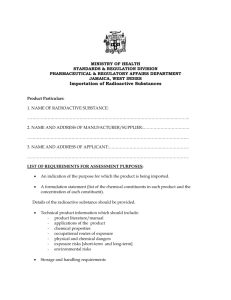
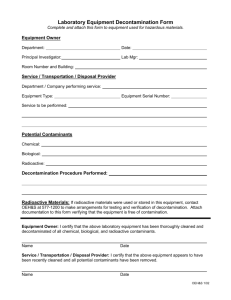
![tutorial #14 [nuclear physics and radioactivity] .quiz](http://s3.studylib.net/store/data/008407305_1-1884988a9e5162a6b7a2b0d0cf8c83c5-300x300.png)

